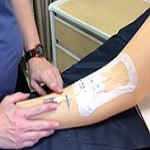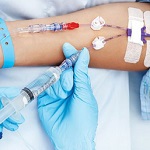

Peripherally inserted central catheter (PICC)
PICC stands for Peripherally Inserted Central Catheter. It’s a type of central line. A PICC is a thin, flexible tube that is inserted into a vein in the upper arm and guided (threaded) into a large vein above the right side of the heart called the superior vena cava. It is used to give intravenous fluids, blood transfusions, chemotherapy, and other drugs.
The line goes into a vein in your arm, under local anaesthetic. A doctor or nurse can put it in during an outpatient appointment. The line runs up the vein inside your arm and ends up in a large vein in your chest.
PICC lines can be left in for several months and used in a similar way to other central lines.
Demonstration Videos
Guidelines, Protocol Manuals
Peripherally Inserted Central Line – Mayo Clinic
Discharge Instructions Caring for Your Peripherally Inserted Central
PERIPHERALLY INSERTED CENTRAL CATHETER: CARE AT HOME
Caring for PICC Line – Peripherally Inserted
Peripherally inserted central catheters are also called PICC lines or central venous catheters (CVC). A PICC line is a small, flexible catheter (tube) that is put into a vein. Veins are blood vessels that carry blood to your heart from the rest of your body. PICC lines are placed into a vein in your arm, and then guided into a larger vein in your chest. A midline catheter is put into a vein by the bend in your elbow or your upper arm. The midline catheter tube is shorter than a PICC line. The midline tube ends in a vein below your armpit. Having a PICC or midline catheter may allow you to receive long-term intravenous (IV) medicine or treatments.
Peripherally inserted central catheter or midline catheter
The PICC line can stay in your arm for as long as 12 months, although the average length is usually about 6 months, depending on your treatment requirements. Your PICC line will need a new dressing once a week and if your line isn’t currently being used for treatment, it will require a flush at this time as well.
You may need to flush the catheter:
- Before giving yourself a medicine or treatment.
- After giving yourself a medicine or treatment.
- Once a day, if you use the PICC or midline catheter often.
- Once a week, if you do not use the PICC or midline catheter often.
Caring for a Peripherally Inserted Central Catheter or Midline Catheter
Medically reviewed by Drugs.com. Last updated on Apr 11, 2019.
What are peripherally inserted central catheters and midline catheters?
Peripherally inserted central catheters are also called PICC lines or central venous catheters (CVC). A PICC line is a small, flexible catheter (tube) that is put into a vein. Veins are blood vessels that carry blood to your heart from the rest of your body. PICC lines are placed into a vein in your arm, and then guided into a larger vein in your chest. A midline catheter is put into a vein by the bend in your elbow or your upper arm. The midline catheter tube is shorter than a PICC line. The midline tube ends in a vein below your armpit. Having a PICC or midline catheter may allow you to receive long-term intravenous (IV) medicine or treatments.
PICC lines and midlines can stay in place longer than some other types of IV catheters. PICCs and midlines are used for IV therapy given for more than five days at a time. Having a PICC or midline may decrease the number of needle sticks that you need to get medicine, or have blood samples collected. PICC and midline catheters have one or more lumens. A lumen is a tube outside of your body with a cap, hub, or port on the end. By having more than one lumen, you may be able to get more than one medicine or treatment at a time.
Why might I need a peripherally inserted central catheter or midline catheter?
You need long-term intravenous therapy. You may need IV antibiotics (germ-killing medicine) or chemotherapy (medicine to treat cancer) for weeks or months. Total parenteral nutrition (liquid food) and IV liquid may also be given through a PICC line. With a PICC line or a midline, you can be treated in a hospital, clinic, or in your own home. If you are treated at home, a nurse may visit your home to help you.
Your veins are hard to insert an IV into, or your medicine is harmful to veins. It may be hard for caregivers to insert an IV tube because your veins are small or damaged. Having a PICC or midline can decrease the number of times your IV must be replaced. PICC and midlines catheters can stay in place longer than some other types of IV catheters. If you need IV medicine that can damage your vein or skin, you may need a PICC or midline. Getting this medicine through a PICC or midline may help prevent vein or skin damage.
You often need blood transfusions or blood drawn for tests. If you need to have blood transfusions often, you may need a PICC or midline. Blood samples may be collected through a PICC or midline catheter. This may be done instead of having a caregiver draw blood using a needle poked into your vein.
You need certain tests: Certain PICC lines may be used to measure the pressure of the blood flowing in your veins. If you need dye for a medical test, it may be given through a special type of PICC line.
What should I know about having a PICC or midline catheter?
Use warm compresses: The area where the PICC or midline was inserted may feel sore. Use a warm compress to decrease pain and swelling in your arm. You can make a warm compress by wetting a small towel with hot water. Wring out the water, wrap the towel in plastic, and put it on the area. Use the compress four times a day, for 10 minutes each time. You may want to do this for three days after the catheter is placed. Prop your arm up on pillows when you are sitting or lying down to decrease swelling.
Nonsteroidal anti-inflammatory medicine: Ask your caregiver if you should use anti-inflammatory medicine (NSAIDs). This medicine may help decrease pain and redness at the place where the catheter enters your skin. You can buy it with or without a prescription. NSAIDs can cause stomach bleeding or kidney problems in certain people. Always read the medicine label and follow the directions on it before using this medicine.
Activities to avoid: Do not go swimming, as this exposes your PICC or midline catheter to germs that can cause infection. Do not lift heavy items or do very hard exercise, such as shovelling. Do not use sharp objects near the catheter to avoid cutting or damaging it. Remind caregivers not to check your blood pressure or give needles in the arm where the catheter is placed.
Bathing: Caregivers may tell you to take showers rather than baths to help prevent infection. When bathing, keep the area where the catheter is inserted covered and sealed with plastic wrap. This will keep the area of skin and the bandage dry, and help prevent an infection.
What should I know about caring for my PICC or midline catheter?
Hand washing: Always wash your hands with soap and water before touching the catheter or the area around it. Washing your hands will help prevent infection. Ask caregivers for information about hand hygiene. Do not touch or handle your catheter unless you need to use it or care for it. Wash your hands and put on new medical gloves before touching or handling your catheter.
Using a medicine pump: A pump may be used to give you medicine through the PICC or midline catheter. You may be taught to prepare and attach your medicine to the pump. Caregivers will teach you how to use your pump. Ask caregivers what to do when the alarm sounds, and how to take care of the pump. Ask caregivers how to wear, carry and use a portable infusion pump if you need one. Ask caregivers to show you how to thread the tubing through your clothing as you get dressed.
Clean the end of the catheter tubing before using the catheter: Before attaching, and after detaching tubing from your catheter, the ends of the tubing (caps, hubs and injection ports) must be cleaned. Cleaning the end of the tubing removes the germs that can cause an infection. A new alcohol pad may be used to clean the end of the tubing. To clean the end of the tubing, wash your hands, and open the package with the new alcohol pad. Put on new medical gloves. Rub the alcohol pad briskly on the cap, hub, or port, and then throw the pad away. Ask your caregiver to show you how to clean the end of the catheter tubing.
Clamping the catheter: You may need to clamp your catheter at certain times, such as when the tubing is being changed. The catheter is clamped to help prevent air from getting in. Ask caregivers if you need to clamp your PICC or midline catheter. Ask them when and how this is done.
Changing the caps and tubing: The caps on the catheter lumens must be changed regularly. The tubing used to give medicine or liquids also must be changed. Ask your caregiver how often these tasks need to be done, and who should do them.
Loop extra tubing: If you have long tubing attached to your catheter, loosely loop the tubing together, and secure it with tape. This will help prevent the PICC or midline catheter from being pulled out of your arm by accident.
When do I change the bandage on my PICC or midline catheter?
Caregivers may change the bandage the day after your PICC or midline catheter is put in. After the first bandage change, ask caregivers when, and how often, to change the bandage. If there are no signs of infection where the catheter enters your skin, weekly bandage changes may be done. The bandage should also be changed if it gets moist, wet, loose, or dirty. Change the bandage if it has moved out of place, and no longer covers or sticks to the point where the catheter enters your skin.
How do I check and clean the area around the catheter and change the bandage?
Check your skin where the catheter enters it every day. Look for signs of infection and other problems. Clean your skin before every bandage change.
Prepare your work area and supplies: Prepare an area for the supplies needed to clean your skin and change your bandage. The area should be away from open windows, heating ducts, and fans. Be sure it is well-lit, clean, and free of dust. Prepare a place to sit or lie down while you work with your catheter. Supplies to take care of your PICC or midline catheter may be sent to your home. Keep them away from children and pets. Your caregiver will teach you how to order more supplies when you need them. You may need the following supplies:
Liquid soap in a pump, or a bottle of waterless soap. This is used to wash your hands.
Paper towels. These are used to dry your hands.
A trash bag.
Solution to clean your skin. Ask your caregiver what solution to use. You may need small packages of gauze to apply the solution.
New gauze bandages and medical tape, or clear adhesive (sticky) bandages. Ask your caregiver which type of bandage to use. If you use a gauze bandage and tape, have four strips of tape ready to secure your bandage. (Tape is not used for clear adhesive bandages.) Open the package with the new bandage, and leave the bandage in it until you are ready to use it.
Sterile (germ-free) or clean medical gloves. You may also need to wear a medical mask. Ask your caregiver if you need to wear a mask.
Wash your hands and put on gloves: Put on the mask if you need to wear it. Gently press on the area where the catheter enters your skin. If you feel pain or discomfort, call your caregiver.
Gently remove the old bandage and throw it into the trash bag: Throw your gloves into the trash bag, and put on new gloves.
Look at the place where the catheter goes into your arm: Look for skin redness, swelling, blood, or fluid. Call your caregiver if you see any of these signs.
Clean the area around your catheter: Prepare to clean your skin with the solution your caregiver suggests. Ask caregivers how to clean your skin. Avoid pulling, pushing on, or moving the catheter. You may clean your skin using a scrubbing back-and-forth movement. You may also start where the catheter enters your skin, and clean outward from it in circles. The circles should get larger as you clean away from the catheter. Throw the swab or gauze used to clean your skin into the trash bag. Let the clean area of skin dry for a few minutes.
Put on the clean bandage: If you use a gauze bandage, place the bandage over the area where the catheter enters your skin. Secure the tape around all edges of the gauze bandage to hold it firmly against your skin. If you use a clear adhesive bandage, remove the backing and carefully place it over the area. Gently smooth the clear adhesive bandage over the area to remove any wrinkles. Remove your gloves and mask and throw them away in the trash bag. Wash your hands.
When and how often should I flush my PICC or midline catheter?
Your PICC or midline catheter may need to be flushed. This is when you push a small amount of medicine or liquid through your PICC or midline catheter using a syringe. Flushing is done to help prevent your catheter from getting blocked. Flushing is also done to help prevent medicines from mixing with each other in the tubing. Ask caregivers when to flush your PICC or midline catheter. You may need to flush the catheter:
- Before giving yourself a medicine or treatment.
- After giving yourself a medicine or treatment.
- Once a day, if you use the PICC or midline catheter often.
- Once a week, if you do not use the PICC or midline catheter often.
- What should I use to flush my PICC or midline catheter?
Ask your caregiver what solution to use to flush the catheter. You may need to use one or both of the following:
Saline: A solution called saline may need to be flushed through your catheter. This liquid may help keep the catheter open and clear.
Heparin: A solution called heparin may need to be flushed through your catheter. Heparin is a medicine that helps prevent blood clots from forming inside the catheter. If heparin is used to flush the catheter, problems including allergic reaction, bleeding, and heparin-induced thrombocytopenia (HIT) could develop. HIT is a low number of blood platelets, which increases the risk of bleeding.
How do I flush my PICC or midline catheter?
Ask your caregiver how to flush your catheter. You may need to do the following:
Wash your hands. Put on medical gloves.
Clean the end of the catheter tubing as your caregiver has shown you.
Push or screw the syringe with the flushing solution into the end of the catheter tubing.
Using the syringe plunger, slowly push the fluid out of the syringe and into the catheter. If it feels hard to push in the plunger, do not force it. Forcing the plunger could damage the catheter, or cause serious harm. Look for kinks in the tubing that may be pinching off the catheter. Straighten any kinks in the tubing. If you do not find a kink, this may mean that your catheter is blocked. Call your caregiver.
After the solution is pushed into the catheter, pull or unscrew the syringe. Dispose of the syringe as your caregiver has told you to, and clean the catheter end. Throw away your gloves, and wash your hands.
How and why would my peripherally inserted central catheter or midline catheter be removed or replaced?
If your treatment lasts longer than expected, your catheter may need to be removed. It may also need to be removed if you get an infection, or have other problems with the catheter. Your catheter may be removed if you get a blood clot in or around it. If your PICC or midline catheter often gets blocked or it is damaged, it will be removed. You may need to have another PICC or midline catheter inserted. Your catheter will be removed if you no longer need IV medicines or treatments.
Your caregiver will remove the catheter for you. He will wash his hands and put on gloves. The bandage will be removed, and germ-killing soap will be used to clean your skin. If stitches are holding your catheter in place, they will be removed. Caregivers may put medicine on your skin to numb it. The skin opening may be cut larger to pull out the catheter. The catheter will be pulled gently out of your vein. Caregivers will hold pressure over the area to help prevent bleeding and other problems. Stitches may be put in to close the opening where the catheter came out of your arm. A new bandage is put over the area.
When should I call my caregiver?
Call your caregiver if:
- You have a fever.
- You feel pain in your arm, neck, shoulder, or chest on the side that your catheter is in.
- The veins in your neck or chest are easier to see, or look larger than usual.
- Your arm, neck, or face is swollen and red on the side that your catheter is in.
- It is hard to push the plunger of the syringe in when giving medicine or flushing your catheter. You may see that liquids are flowing into the catheter more slowly. Check for kinks in the tubing. Straighten out any kinks that you find. If liquid keeps flowing in slower than it should, call your caregiver.
- You see air in the tubing.
- You feel pain when liquid is going into your PICC or midline catheter.
- You see that the catheter is getting shorter or longer.
- There is new or more blood on your bandage.
- Your bandage gets wet, loose, dirty, or falls off, and you do not know how to change it.
- You run out of supplies to care for your catheter.
When should I seek immediate help?
Call 911 or go to the emergency room if:
- The area around where the catheter enters your skin looks red, feels warm or painful, or it is oozing fluid.
- You see a red line going up your arm from the place where the catheter enters your skin. Your arm will also be painful.
- You see blisters around the place where the catheter enters your skin.
- Your PICC line or midline is cracked or has a hole in it. If you see a crack or hole, clamp your catheter above it and see your caregiver immediately.
- Your PICC or midline catheter falls out, or is pulled out by accident.
- Your arm or leg feels warm, tender, and painful. It may look swollen and red.
- You have chest pain or trouble breathing that is getting worse over time.
- You suddenly feel lightheaded and have trouble breathing.
- You have new and sudden chest pain. You may have more pain when you take deep breaths or cough. You may cough up blood.
Related Devices
Central-line-or-picc-line-dressing-change
Central Line Dressing Change A central line (PICC, port, Read more...
How to prepare and administer TPN Instructions
TPN Administered TPN administration into a vein, Read more...
Flushing a port a cath Instructions
Flushing a Port a Cath Normal saline Read more...
Dressing Change & Flush Port-a-Cath Instructions
Dressing Change & Flush Port-a-Cath A port-a-cath is a device Read more...
Access Port-a-cath Instructions
Port-a-cath A port-a-cath, also referred to as Read more...
Central Line Dressing Change Instructions
Central Line Dressing Change A central line (PICC, port, Read more...
Patient Learning Center

